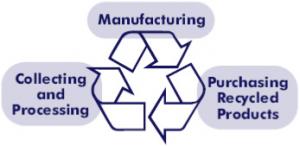What is Recycling?
The following excerpt is quoted from the Environmental Protection Agency (EPA) guidelines for recycling, The Quest for Less.
Recycling is a series of activities that includes the collection of used, reused, or unused items that would otherwise be considered waste, sorting and processing the recyclable products into raw materials, and remanufacturing the recycled raw materials into new products.
Consumers provide the last link in recycling by purchasing products made from recycled content. Recycling also can include composting of food scraps, yard trimmings, and other organic materials.
Source: The Quest for Less, Chapter 2, Section 2, Environmental Protection Agency
Glass, plastics, paper, aluminum, steel, and some electronics are considered recyclable products. Even recycling cell phones helps the environment. It saves energy and keeps usable materials out of landfills. Cell phones and personal digital assistants (PDAs) are made of precious metals, copper, and plastics, all of which require energy to mine and manufacture. Recycling conserves these materials so they can be turned into new products. Recycling has a number of benefits that help both the environment and the economy.
Visit the EPA website for more information on the benefits of recycling.
Recyclable materials can be collected in a variety of ways. There is curbside collection in neighborhoods, business collections, drop-off centers, etc. Check with your local community to determine what recycling facilities are available and what products can be recycled at those facilities.
In your notes, answer the following questions.
Recycling in action:
Source: Plastic Recycling, sheimaginespeace, YouTube
Proper Disposal of Science Laboratory Waste
Proper disposal of laboratory wastes is essential in maintaining the health of the environment.
Wastes can be considered hazardous or non-hazardous:
- Hazardous materials should only be disposed of at approved disposal facilities.
- Check with your teacher to discover the locations of these facilities.
- Always follow your teacher's instructions and guidelines for disposal of laboratory wastes.
- Solid chemicals, metals, matches, filter papers, broken glass, and other materials specified by your teacher need to be disposed of in the proper containers designated for those specific wastes.
- Only use the sink to dispose of water and any solution specifically mentioned by your teacher.
- Do not pour chemicals down the drain.
A Material Safety Data Sheet or MSDS is a document that contains information on a chemical's potential hazards (health, fire, reactivity, and environmental) and how to work safely with that product.
An MSDS also contains information on the use, storage, disposal, and emergency procedures to be followed if a spill or leak of the material occurs.
All chemicals in a laboratory should have a MSDS available. Read MSDS information and follow teacher instructions to ensure laboratory material disposal is environmentally sound and safe.
Source: National Prosthetics and Orthotics Boston, Nadya Peek, Flickr
Classroom Disposal Practices
You have been assigned to be the classroom waste management monitor. One part of your job is to keep track of what is thrown away in the classroom.
Below are items that you found in the trashcan. You must decide if the item should have been reused, recycled, or thrown away.
Drag each item to the appropriate disposal choice for that item.
Another part of your job is to help clean up after experiments: One day you find several items have been left out in the lab by forgetful students. You must determine the proper handling of these items.
First, refer to the Disposal Methods Index and identify the item.
(Source: Laboratory Safety Guide Appendix A, University of Wisconsin - Facilities, Planning & Management)
Next, refer to the Disposal Method Descriptions to determine proper disposal practices for the item.
(Source: Laboratory Safety Guide Chapter 7, University of Wisconsin - Facilities, Planning & Management)
In your notes, record the correct disposal technique. Did you make the right decisions?
Find the Recyclables
Find the recyclables in the lab: Drag the names of the recyclable objects to the recycling bin.
Source for images used in this section, as they appear, top to bottom:
Chemistry Lab, Paillasse Chimie, Jean-Pierre, Wikimedia
Recycling Bin, Open Clip art Library
Recycle City
Visit the EPA's Recycle City
Click on the following buildings to view the recycling efforts at that location:
- School
- Shaq's Garage
- Widget Manufacturing Company
Complete the following activity in your notes.
Name three ways each site contributes to the "reduce, reuse, and recycle" efforts of Recycle City. Compare your answers to those listed below.
Dumptown Game
Visit the EPA's Dumptown Game.
Follow the instructions on the website and manipulate various aspects of the town to see the effects. Notice the current waste "meter" and the cost effectiveness of the various programs.
Answer the following questions in your notes:
Proper Disposal of Chemicals in Your Home
Schools contract with companies to properly dispose of chemicals and materials that cannot be thrown away or disposed of down the drain. What about chemical products in your home? What household products are considered hazardous? How should we properly dispose of chemicals we use in our homes?
Visit the Household Hazardous Waste page of the EPA website.
Answer the following questions in your notes.

